Operators
 Philippines
Philippines
| XT-004 Layang | |
|---|---|
| Role | Basic trainer aircraft |
| National origin | Philippines |
| Manufacturer | Philippine Air Force |
| First flight | 21 July 1996 [1] |
| Status | Cancelled |
| Primary user | Philippine Air Force |
| Number built | 1 prototype |
| Developed from | SIAI-Marchetti SF.260 |
The PAF XT-004 Layang was a basic trainer aircraft developed by the Philippine Air Force's Air Force Research and Development Center (AFRDC). [2]
After an intensified and revitalized self-reliance program in 1996, the XT-004 project, code-named "Layang", was developed by the PAFRDC in Villamor Air Base, Pasay. It is a single-engine aircraft powered by a 350 hp Allison Model 250-B17D turboshaft engine and is constructed from aluminum with a semi-monocoque structure. According to the PAFRDC, the aircraft jigs and fixtures have already been built since 1985, but lack of funds hindered the completion of the project. [2]
Aircraft of comparable role, configuration, and era
Related lists

The Bell UH-1 Iroquois is a utility military helicopter designed and produced by the American aerospace company Bell Helicopter. It is the first member of the prolific Huey family, as well as the first turbine-powered helicopter in service with the United States military.

The North American Rockwell OV-10 Bronco is an American twin-turboprop light attack and observation aircraft. It was developed in the 1960s as a special aircraft for counter-insurgency (COIN) combat, and one of its primary missions was as a forward air control (FAC) aircraft. It can carry up to 3,200 lb (1,450 kg) of external munitions and internal loads such as paratroopers or stretchers, and can loiter for three or more hours.
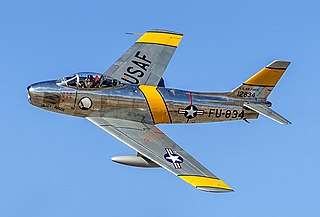
The North American F-86 Sabre, sometimes called the Sabrejet, is a transonic jet fighter aircraft. Produced by North American Aviation, the Sabre is best known as the United States' first swept-wing fighter that could counter the swept-wing Soviet MiG-15 in high-speed dogfights in the skies of the Korean War (1950–1953), fighting some of the earliest jet-to-jet battles in history. Considered one of the best and most important fighter aircraft in that war, the F-86 is also rated highly in comparison with fighters of other eras. Although it was developed in the late 1940s and was outdated by the end of the 1950s, the Sabre proved versatile and adaptable and continued as a front-line fighter in numerous air forces.
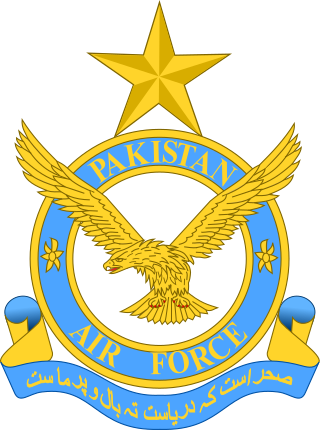
The Pakistan Air Force (PAF) is the aerial warfare branch of the Pakistan Armed Forces, tasked primarily with the aerial defence of Pakistan, with a secondary role of providing air support to the Pakistan Army and Pakistan Navy when required, and a tertiary role of providing strategic airlift capability to Pakistan. As of 2024, as per the International Institute for Strategic Studies, the PAF has more than 35,000 active-duty personnel. PAF stands as the eight largest Air Force in the world. PAF is the largest Air Force of the Muslim world in terms of aircraft fleet. Its primary mandate and mission is "to provide, in synergy with other inter-services, the most efficient, assured and cost effective aerial defence of Pakistan." Since its establishment in 1947, the PAF has been involved in various combat operations, providing aerial support to the operations and relief efforts of the Pakistani military. Under Article 243, the Constitution of Pakistan appoints the President of Pakistan as the civilian Commander-in-Chief of the Pakistan Armed Forces. The Chief of the Air Staff (CAS), by statute a four-star air officer, is appointed by the President with the consultation and confirmation needed from the Prime Minister of Pakistan.

The SIAI-Marchetti S.211 is a turbofan-powered military trainer aircraft designed and originally marketed by Italian aviation manufacturer SIAI-Marchetti.

The Chengdu J-10 Vigorous Dragon, is a medium-weight, single-engine, multirole combat aircraft using a delta wing and canard design. It is produced by the Chengdu Aircraft Corporation (CAC) for the People's Liberation Army Air Force (PLAAF), Pakistan Air Force (PAF) and People's Liberation Army Naval Air Force (PLANAF). The J-10 is mainly designed for air-to-air combat, but can also perform strike missions.
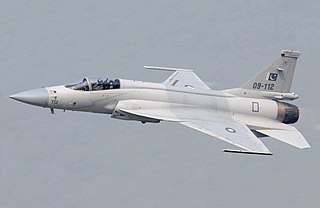
The CAC/PAC JF-17 Thunder, or FC-1 Xiaolong, is a lightweight, single-engine, multirole combat aircraft developed jointly by the Pakistan Aeronautical Complex (PAC) and Chengdu Aircraft Corporation (CAC) of China. It was designed and developed as a replacement for the A-5C, F-7P/PG, Mirage III, and Mirage V combat aircraft in the Pakistan Air Force (PAF). The JF-17 can be used for multiple roles, including interception, ground attack, anti-ship, and aerial reconnaissance. The Pakistani designation "JF-17" stands for "Joint Fighter-17", with the "Joint Fighter" denoting the joint Pakistani-Chinese development of the aircraft and the "-17" denoting that, in the PAF's vision, it is the successor to the F-16. The Chinese designation "FC-1" stands for "Fighter China-1".

The KAI T-50 Golden Eagle (Korean: 골든이글) is a family of South Korean supersonic advanced jet trainers and light combat aircraft, developed by Korea Aerospace Industries (KAI) with Lockheed Martin. It is South Korea's first indigenous supersonic aircraft and one of the world's few supersonic trainers.

The Pakistan Aeronautical Complex (PAC) is a major defense contractor and an aerospace manufacturer that is headquartered in Kamra, Punjab, Pakistan.

The GAF Nomad is a utility aircraft produced by the Government Aircraft Factories (GAF) of Australia in Melbourne. The twin-turboprop, high-wing aircraft has a retractable gear and came in two variants: the initial N22, followed by the stretched N24. Supported by the Australian Government, design work began in the mid-1960s, and it made its maiden flight on 23 July 1971. Despite some export sales and commercial operations, sales were not sufficient and production stopped in 1985.
The PADC Defiant was a trainer and light attack aircraft formerly developed by the Philippine Aerospace Development Corporation to reduce dependence on second-hand aircraft for the Philippine Air Force.

Cesar Basa Air Base, or simply Basa Air Base, is an airbase currently operated by the Philippine Air Force. It is located at Floridablanca, Pampanga about 40 miles (64 km) northwest of Metro Manila in the Philippines. It is named after César Basa, one of the pioneer fighter pilots of the Philippine Air Force.
Project Sabre II was the Pakistan Air Force's program to develop a feasible and low-cost multirole combat jet based on an existing design—the Chengdu F-7 Skybolt, a Chinese variant of the MiG–21. The Pakistan Air Force (PAF) initiated Project Sabre II in 1987, hiring the American aerospace firm Grumman, to provide crucial expertise to refine the baseline aircraft design along with specialists from the PAF and the Chinese People's Liberation Army Air Force (PLAAF).
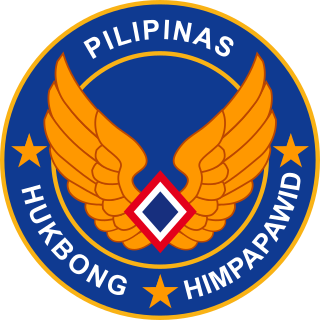
The Philippine Air Force (PAF) is the aerial warfare service branch of the Armed Forces of the Philippines. Initially formed as part of the Philippine Army as the Philippine Army Air Corps (PAAC) in 1935, the PAAC eventually saw combat during World War 2 and was formally separated from the Army in 1947 as a separate service branch of the AFP under Executive Order No. 94. At present, the PAF is responsible for both defending Philippine airspace, and conducting aerial operations throughout the Philippines, such as close air support operations, combat air patrols, aerial reconnaissance missions, airlift operations, helicopter tactical operations, special operations, and aerial humanitarian operations, which includes search and rescue operations. The PAF has also carried out various missions within the country and abroad.
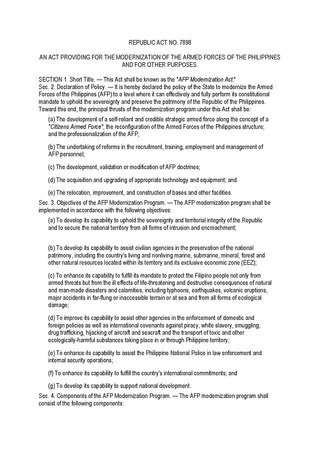
The Armed Forces of the Philippines (AFP) Modernization Act, officially designated as Republic Act No. 7898, was a Philippine law that was enacted on February 23, 1995, by President Fidel V. Ramos. It was aimed to modernize all branches of the Armed Forces of the Philippines (AFP) such as the Philippine Air Force, Philippine Navy, and the Philippine Army. The law was amended by Republic Act No. 10349, also known as the Revised AFP Modernization Act, on December 11, 2012.
The PADC Hummingbird was a light utility helicopter that was developed by the Philippine Aerospace Development Corporation to reduce dependence on second-hand aircraft for the Philippine Air Force.
The PAF XT-001 Marko 1 was a basic trainer aircraft developed by the Philippine Air Force Self-Reliance Development Wing (PAFSRDW).
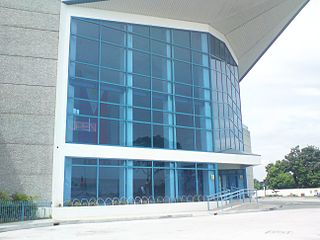
The Philippine Air Force Aerospace Museum is an aerospace museum located within the premises of Colonel Jesus Villamor Air Base in Pasay, Philippines.
Rozzano Dosado Briguez is a Filipino general who formerly served as the Commanding General of the Philippine Air Force. He is a graduate of the Philippine Military Academy "Sinagtala" Class of 1986, and graduated as Top 2 of his class. He was also a commander of the AFP Western Command, and formulated the new command framework: "Padayon PAF: Perform, Reform, Transform", a framework of his leadership philosophy in the Philippine Air Force.